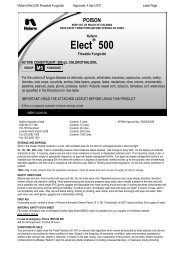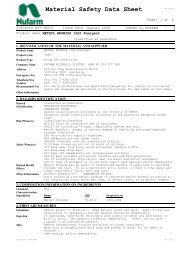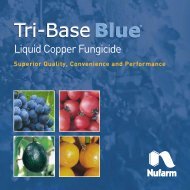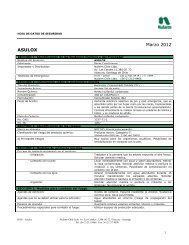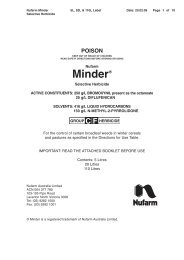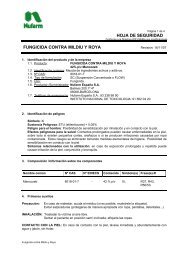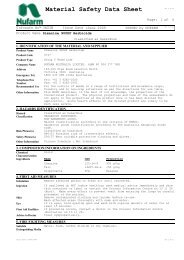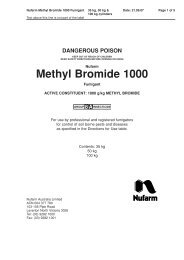MSDS - Nufarm
MSDS - Nufarm
MSDS - Nufarm
Create successful ePaper yourself
Turn your PDF publications into a flip-book with our unique Google optimized e-Paper software.
Material Safety Data Sheet<br />
CS: 1.4.21<br />
Page: 1<br />
of<br />
6<br />
CS: 1.4.21<br />
Infosafe No NU00W Issue Date : July 2009 ISSUED by NUFARM<br />
Product Name CHLORPYRIFOS 500EC Insecticide<br />
Classified as hazardous<br />
1. IDENTIFICATION OF THE MATERIAL AND SUPPLIER<br />
Product Name CHLORPYRIFOS 500EC Insecticide<br />
Product Code 1030<br />
Product Type Group 1B Insecticide<br />
Company Name NUFARM AUSTRALIA LIMITED. (ABN 80 004 377 780)<br />
Address<br />
103-105 Pipe Road Laverton North<br />
Victoria 3026 Australia<br />
Emergency Tel. 1800 033 498 (24hr Australia)<br />
Telephone/Fax Tel: +61 3 9282-1000<br />
Number<br />
Fax: +61 3 9282-1001<br />
Recommended Use For control of a wide range of insect pests on fruit, vegetables, oilseeds,<br />
cotton, cereals, pasture, turf and other situations as specified in the<br />
Directions for Use Table on the label.<br />
THIS PRODUCT IS TOO HAZARDOUS FOR USE BY HOUSEHOLDERS.<br />
HOUSEHOLDERS MUST NOT USE THIS PRODUCT IN OR AROUND THE HOME.<br />
Other Information This <strong>MSDS</strong> describes, to the best of our knowledge, the properties of the<br />
concentrated product. The physical properties and some of the assessments do<br />
not apply to the properties of the product once it has been diluted for<br />
application. Acute health effects of the diluted product are likely to be<br />
much less severe.<br />
2. HAZARDS IDENTIFICATION<br />
Hazard<br />
Classified as hazardous<br />
Classification HAZARDOUS SUBSTANCE.<br />
DANGEROUS GOODS.<br />
Hazard classification according to the criteria of NOHSC.<br />
Dangerous goods classification according to the Australia Dangerous Goods<br />
Code.<br />
Risk Phrase(s) Classified as hazardous<br />
R24/25 Toxic in contact with skin and if swallowed.<br />
R65 Harmful: may cause lung damage if swallowed.<br />
Safety Phrase(s) S28 After contact with skin, wash immediately with plenty of water<br />
S36/37 Wear suitable protective clothing and gloves.<br />
S45 In case of accident or if you feel unwell seek medical advice immediately<br />
S62 If swallowed, do not induce vomiting; seek medical advice immediately and<br />
show this container or label.<br />
Other Information Poisons Schedule S6<br />
3. COMPOSITION/INFORMATION ON INGREDIENTS<br />
Chemical<br />
Liquid<br />
Characterization<br />
Ingredients<br />
Name<br />
CAS<br />
Chlorpyrifos<br />
2921-88-2<br />
Liquid<br />
64742-94-5<br />
Hydrocarbons<br />
Other ingredients<br />
(considered<br />
non-hazardous)<br />
Substance Chemical Organophosphate<br />
Family<br />
Proportion<br />
500 g/L<br />
480 g/L<br />
Balance<br />
4. FIRST AID MEASURES<br />
Inhalation<br />
Remove patient to fresh air. Obtain medical advice.<br />
Ingestion<br />
If swallowed do NOT induce vomiting; seek medical advice immediately and show<br />
this container or label or contact the Poisons Information Centre on 13 11 26<br />
(Aust). Make every effort to prevent vomit from entering the lungs by careful<br />
placement of the patient.<br />
The above first aid instructions are mandated by the Commonwealth Department<br />
Print Date: 23/07/2009 CS: 1.4.21
Material Safety Data Sheet<br />
CS: 1.4.21<br />
Page: 2<br />
of<br />
6<br />
CS: 1.4.21<br />
Infosafe No NU00W Issue Date : July 2009 ISSUED by NUFARM<br />
Product Name CHLORPYRIFOS 500EC Insecticide<br />
Classified as hazardous<br />
of Health and Ageing via the National Drugs and Poisons Schedule. These<br />
instructions are suitable for ingestion of spray solution and small amounts of<br />
concentrate; however, if SUBSTANTIAL AMOUNTS of the concentrate have been<br />
swallowed (more than about one teaspoon) AND if medical assistance is more<br />
than 30 minutes away, the induction of vomiting should be CONSIDERED,<br />
preferably based on MEDICAL ADVICE if a physician can be contacted by phone.<br />
All care must be taken to prevent vomit from being inhaled. Do not give<br />
anything by mouth to a semi-conscious or unconscious person.<br />
Skin<br />
If skin contact occurs, remove contaminated clothing and wash skin thoroughly<br />
with water.<br />
Seek medical advice, but only after the exposed skin has been thoroughly<br />
washed.<br />
Eye<br />
If in eyes, hold eyelids open and wash with copious amounts of water for at<br />
least 15 minutes.<br />
Seek medical advice.<br />
First Aid Facilities If poisoning occurs, contact a doctor or the Poisons Information Centre<br />
(Australia) on 13 11 26.<br />
Advice to Doctor An anticholinesterase compound.<br />
If the material is dissolved in solvents, e.g., petroleum solvents, vomiting<br />
may cause pulmonary aspiration. Instead, the stomach should be emptied as soon<br />
as possible by careful gastric lavage (using a cuffed endotracheal tube<br />
already in place). Artificial respiration should be started at the first sign<br />
of respiratory failure. Cautious administration of fluids is advised, as well<br />
as general supportive and symptomatic pharmacological treatment and absolute<br />
rest. As early as possible, administer 2 mg of atropine sulfate i.v. and<br />
1000-2000 mg of pralidoxime chloride or 250 mg of obidoxime chloride (adult<br />
dose) i.v. to patients suffering from severe respiratory difficulties,<br />
convulsions, and unconsciousness. Repeated doses of 2 mg of atropine sulfate<br />
should be given, as required, based on the respiration, blood pressure, pulse<br />
frequency, salivation, and convulsion conditions. The dose and the frequency<br />
of atropine varies with each patient, but the patient should remain fully<br />
atropinised (signs include dilated pupils, dry mouth, skin flushing).<br />
Diazepam should be given in all but the mildest cases in doses of 10 mg, s.c.<br />
or i.v., which may be repeated as required. For children, the doses are<br />
0.04-0.08 mg of atropine/kg body weight, 250 mg of pralidoxime chloride per<br />
child, or 4-8 mg of obidoxime chloride/kg body weight. Morphine, barbiturates,<br />
phenothiazine derivatives, tranquillizers, and all kinds of central stimulants<br />
are contraindicated.<br />
5. FIRE FIGHTING MEASURES<br />
Suitable<br />
Water fog, foam, carbon dioxide or dry chemical.<br />
Extinguishing Media<br />
Hazards from<br />
Combustion<br />
Products<br />
Special Protective<br />
Equipment for fire<br />
fighters<br />
Hazchem Code<br />
Emergency Action in<br />
case of Fire<br />
Other Information<br />
May emit toxic fumes of hydrogen chloride or phosgene if involved in fires or<br />
exposed to extreme heat.<br />
Breathable air apparatus may have to be worn if material is involved in fires<br />
especially in confined spaces.<br />
2X<br />
If exposed to fire, keep container cool by spraying with water.<br />
STOP FIRE WATER FROM ENTERING DRAINS OR WATER BODIES.<br />
6. ACCIDENTAL RELEASE MEASURES<br />
Spills & Disposal Contain spill and absorb with clay, sand, soil or proprietary absorbent (such<br />
as vermiculite).<br />
Collect spilled material and waste in sealable open-top type containers for<br />
disposal.<br />
Dispose of at a landfill in accordance with local regulations.<br />
If possible, ring 1800 033 498 for specialist advice.<br />
Personal Protection For appropriate personal protective equipment (PPE), refer Section 8.<br />
Print Date: 23/07/2009 CS: 1.4.21
Material Safety Data Sheet<br />
CS: 1.4.21<br />
Page: 3<br />
of<br />
6<br />
CS: 1.4.21<br />
Infosafe No NU00W Issue Date : July 2009 ISSUED by NUFARM<br />
Product Name CHLORPYRIFOS 500EC Insecticide<br />
Clean-up Methods -<br />
Large Spillages<br />
Environmental<br />
Precautions<br />
7. HANDLING AND STORAGE<br />
Conditions for Safe<br />
Storage<br />
Other Information<br />
Classified as hazardous<br />
Place damaged containers in recovery bins (if available) and return to<br />
manufacturer.<br />
Prevent from entering drains, waterways or sewers.<br />
Store in the closed, original container in a cool, well ventilated area.<br />
Do not store for prolonged periods in direct sunlight.<br />
Keep container tightly sealed and do not store with seed, fertilisers or<br />
foodstuffs.<br />
Always read the label and any attached leaflet before use.<br />
8. EXPOSURE CONTROLS/PERSONAL PROTECTION<br />
National Exposure<br />
Standards<br />
Engineering<br />
Controls<br />
Respiratory<br />
Protection<br />
Personal Protective<br />
Equipment<br />
Hygiene Measures<br />
Requirements<br />
Concerning Special<br />
Training<br />
No biological exposure limit allocated.<br />
NOHSC has set the following exposure standard for chlorpyrifos : TLV (TWA)<br />
0.2 mg/m3, STEL -. SK<br />
'SK' notice - absorption through the skin may be a significant source of<br />
exposure. The exposure standard is invalidated if such contact should occur.<br />
The manufacturer of the solvent has recommended an occupational exposure<br />
limit of 100 mg/m3; 17ppm TWA, as total hydrocarbon.<br />
Handle in well ventilated areas, generally natural ventilation is adequate.<br />
If exposure to vapour or spray is expected, a half face respirator with<br />
cartridge type A is recommended.<br />
When opening the container, preparing spray and using the prepared spray wear<br />
cotton overalls buttoned to the neck and wrist and a washable hat,<br />
elbow-length PVC gloves and face shield or goggles.<br />
Wear impervious footwear such as plastic or rubber boots.<br />
Re-entry period: Do not enter treated area until spray has dried.<br />
After use and before eating, drinking or smoking, wash hands, arms and face<br />
thoroughly with soap and water.<br />
After each day's use, wash contaminated clothing and safety equipment.<br />
NSW regulations require that people who use pesticides in their job or<br />
business must have training in the application of the materials.<br />
9. PHYSICAL AND CHEMICAL PROPERTIES<br />
Form<br />
Liquid<br />
Appearance Straw coloured liquid.<br />
Melting Point 150°C<br />
Solubility in Water Forms an emulsion in water.<br />
Specific Gravity 1.09 - 1.11<br />
pH Value<br />
neutral<br />
Vapour Pressure 2.7 mPa @ 25°C for chlorpyrifos<br />
Vapour Density >1<br />
(Air=1)<br />
Volatile Component 40 - 50%<br />
Surface Tension 26.6 mN/M<br />
Flash Point<br />
68°C (PMCC - AS2106)<br />
Flammability Combustible liquid. The spray mixture is not combustible.<br />
Flammable Limits - 0.6% v/v for solvent<br />
Lower<br />
Flammable Limits - 7.0% v/v for solvent<br />
Upper<br />
Print Date: 23/07/2009 CS: 1.4.21
Material Safety Data Sheet<br />
CS: 1.4.21<br />
Page: 4<br />
of<br />
6<br />
CS: 1.4.21<br />
Infosafe No NU00W Issue Date : July 2009 ISSUED by NUFARM<br />
Product Name CHLORPYRIFOS 500EC Insecticide<br />
Kinematic Viscosity<br />
4.56 x 10-6 m2/sec<br />
10. STABILITY AND REACTIVITY<br />
Incompatible<br />
Materials<br />
Hazardous Reactions<br />
Hazardous<br />
Polymerization<br />
Classified as hazardous<br />
Avoid contact of the concentrate with strong alkalis and alkaline materials<br />
such as lime.<br />
Avoid contact of the concentrate with strong acids.<br />
Keep away from strong oxidising agents, may react violently.<br />
Hazardous polymerisation is not possible.<br />
11. TOXICOLOGICAL INFORMATION<br />
Toxicology<br />
No harmful effects are expected if the precautions on the label and this <strong>MSDS</strong><br />
Information are followed.<br />
Inhalation<br />
When applying the product as a spray avoid breathing in spray mist.<br />
Breathing in high concentrations of vapour can produce central nervous system<br />
depression, which can lead to loss of coordination, impaired judgement and if<br />
exposure is prolonged, unconsciousness.<br />
Ingestion<br />
Possible symptoms of exposure include: nausea, vomiting and central nervous<br />
system depression.<br />
If aspirated into the lung, e.g. from vomiting, the presence of solvent may<br />
result in chemical pneumonitis or pulmonary oedema.<br />
Skin<br />
The rate of absorption for chlorpyrifos is low hence, the product is<br />
moderately toxic by this route.<br />
Prolonged contact with the concentrate can cause defatting of the skin and may<br />
result in dermatitis.<br />
Eye<br />
The concentrate may cause irritation of the eyes.<br />
Chronic Effects Regular exposure may result in lowering of cholinesterase activity which will<br />
recover within a few days after exposure ceases.<br />
Reproductive Data indicates no reproductive effects.<br />
Toxicity<br />
Data indicates no teratogenic effects.<br />
Carcinogenicity Data indicates no carcinogenic effects.<br />
Acute Toxicity - Oral LD50 (male rat) 345 mg/kg for a similar formulation<br />
LD50 (female rat) 230 mg/kg for a similar formulation<br />
LD50 (rat) 135 - 163 mg/kg for chlorpyrifos<br />
LD50 (guinea pig) 504 mg/kg for chlorpyrifos<br />
LD50 (rabbit) 1000 - 2000 mg/kg for chlorpyrifos<br />
Acute Toxicity - LD50 (rat) 409 mg/kg for a similar formulation<br />
Dermal<br />
LD50 (rat) >2000 mg/kg for chlorpyrifos<br />
LD50 (rabbit) >5000 mg/kg for chlorpyrifos<br />
Acute Toxicity - LC50 (rat) (4hr) >0.2 mg/l for chlorpyrifos<br />
Inhalation<br />
Skin Sensitisation Product is not a skin sensitiser.<br />
Other Information The Australian Acceptable Daily Intake (ADI) for chlorpyrifos for a human is<br />
0.003 mg/kg/day, set for the public for daily, lifetime exposure. This is<br />
based on the NOEL of 0.03 mg/kg/day, the level determined to show no effects<br />
during long term exposure for the most sensitive indicators and the most<br />
sensitive species. (Ref: Comm. Dept. of Health and Ageing Office of Chemical<br />
Safety, 'ADI List', December 2008).<br />
12. ECOLOGICAL INFORMATION<br />
Persistence / Average field half life of chlorpyrifos is 33 - 56 days.<br />
Degradability<br />
Known Harmful The product is a marine pollutant for sea transport.<br />
Effects on the<br />
Environment<br />
Other Precautions Do not contaminate dams, waterways or sewers with this product or the<br />
containers which have held this product.<br />
Do not spray on vegetation where honeybees are foraging.<br />
Environ. Protection Spray drift should be avoided, read the label for more information.<br />
Acute Toxicity - Fish The following is data for the active ingredient, chlorpyrifos.<br />
Print Date: 23/07/2009 CS: 1.4.21
Material Safety Data Sheet<br />
CS: 1.4.21<br />
Page: 5<br />
of<br />
6<br />
CS: 1.4.21<br />
Infosafe No NU00W Issue Date : July 2009 ISSUED by NUFARM<br />
Product Name CHLORPYRIFOS 500EC Insecticide<br />
Acute Toxicity -<br />
Daphnia<br />
Acute Toxicity -<br />
Other Organisms<br />
Classified as hazardous<br />
LC50 (96hr) for bluegill sunfish is 0.002 - 0.010 mg/l.<br />
LC50 (96hr) for rainbow trout is 0.007 - 0.051 mg/l.<br />
Very toxic to fish.<br />
LC50 (48hr) for chlorpyrifos is 0.0017 mg/l.<br />
Moderately toxic to birds.<br />
LD50 for mallard ducks is 490 mg/kg<br />
Bees: Toxic to bees. LD50 is 0.07 µg/bee.<br />
13. DISPOSAL CONSIDERATIONS<br />
Product Disposal Ideally, the product should be used for its intended purpose. If there is a<br />
need to dispose of the product, approach local authorities who hold periodic<br />
collections of unwanted chemicals (ChemClear®).<br />
On site disposal of the concentrated product is not acceptable.<br />
Container Disposal Do not use this container for any other purpose.<br />
Triple rinse containers, add rinsate to the spray tank, then offer the<br />
container for recycling/reconditioning, or puncture top, sides and bottom and<br />
dispose of in landfill in accordance with local regulations.<br />
drumMUSTER is the national program for the collection and recycling of empty,<br />
cleaned, non returnable crop production and on-farm animal health chemical<br />
containers. If the label on your container carries the drumMuster symbol,<br />
triple rinse the container, ring your local Council, and offer the container<br />
for collection in the program.<br />
If no landfill is available, bury the containers below 500mm in a disposal pit<br />
specifically marked and set up for this purpose clear of waterways, desirable<br />
vegetation and tree roots.<br />
Empty containers and product should not be burnt.<br />
14. TRANSPORT INFORMATION<br />
Transport<br />
It is good practice to separate this product from food, food related<br />
Information materials, animal feedstuffs, seed or fertilisers during transport.<br />
U.N. Number 3018<br />
Proper Shipping ORGANOPHOSPHORUS PESTICIDE, LIQUID, TOXIC - (CHLORPYRIFOS)<br />
Name<br />
DG Class 6.1<br />
Hazchem Code 2X<br />
Packaging Method 3.8.6<br />
Packing Group III<br />
Storage and Considered dangerous for transport by the Australian Code for the Transport of<br />
Transport<br />
Dangerous Goods by Road and Rail.<br />
EPG Number 6A3<br />
IERG Number 35<br />
15. REGULATORY INFORMATION<br />
Poisons Schedule S6<br />
National and or<br />
International<br />
Regulatory<br />
Information<br />
Packaging &<br />
Labelling<br />
Hazard Category<br />
AICS (Australia)<br />
16. OTHER INFORMATION<br />
There is a legislative requirement in most States in Australia for workers to<br />
be medically monitored when using organophosphates, by:- 'estimation of red<br />
cell and plasma cholinesterase acivity towards the end of the day on which<br />
organophosphates have been used'.<br />
Ref: Control of Workplace Hazardous Substances, NOHSC:1005.<br />
POISON<br />
KEEP OUT OF REACH OF CHILDREN<br />
READ SAFETY DIRECTIONS BEFORE OPENING OR USING<br />
Toxic<br />
All of the components in this product are listed on the Australian Inventory<br />
of Chemical Substances.<br />
Print Date: 23/07/2009 CS: 1.4.21
Material Safety Data Sheet<br />
CS: 1.4.21<br />
Page: 6<br />
of<br />
6<br />
CS: 1.4.21<br />
Infosafe No NU00W Issue Date : July 2009 ISSUED by NUFARM<br />
Product Name CHLORPYRIFOS 500EC Insecticide<br />
Date of preparation<br />
or last revision of<br />
<strong>MSDS</strong><br />
Contact<br />
Person/Point<br />
Revisions<br />
Highlighted<br />
Revised 23/07/2009<br />
Classified as hazardous<br />
Normal Hours: Mr Volker Maier Phone: +61 3 9282 1000<br />
After Hours: Shift Supervisor Phone: 1800 033 498<br />
The <strong>MSDS</strong> was reviewed. Various changes were made to the information.<br />
References to the use of atropine have been removed as per the APVMA.<br />
Other minor changes made and HazChem code is now 2X.<br />
...End Of <strong>MSDS</strong>...<br />
© Copyright ACOHS Pty Ltd<br />
Copyright in the source code of the HTML, PDF, XML, XFO and any other electronic files rendered by an Infosafe system for Infosafe <strong>MSDS</strong> displayed on this site is the<br />
intellectual property of Acohs Pty Ltd.<br />
Copyright in the layout, presentation and appearance of each Infosafe <strong>MSDS</strong> displayed on this site is the intellectual property of Acohs Pty Ltd.<br />
The compilation of <strong>MSDS</strong>'s displayed on this site is the intellectual property of Acohs Pty Ltd.<br />
Copying of any <strong>MSDS</strong> displayed on this site is permitted for personal use only and otherwise is not permitted. In particular the <strong>MSDS</strong>'s displayed on this site cannot be<br />
copied for the purpose of sale or licence or for inclusion as part of a collection of <strong>MSDS</strong> without the express written consent of Acohs Pty Ltd.<br />
Print Date: 23/07/2009 CS: 1.4.21



